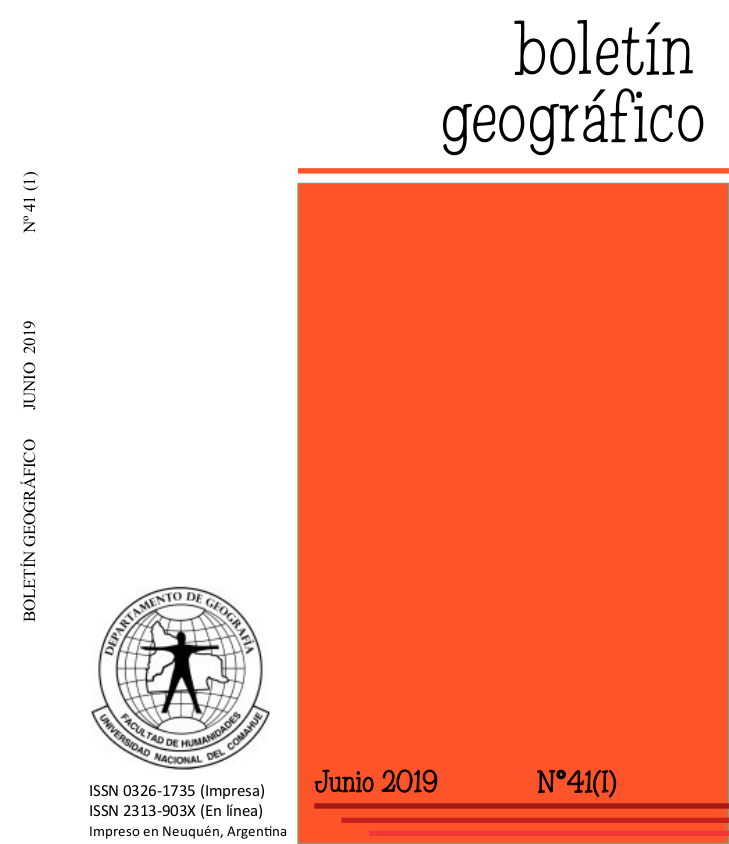Influence of edaphic/climatic factor on microbial population in arid soils with irrigated agriculture
Keywords:
Biological activity, Irrigation, Arid ecosystemsAbstract
The agricultural frontier over the arid marginal zones is steadily expanding by means of irrigation technology. Considering the impact of bacterial population and its biological activity on soil homeostasis, information on soil biodiversity and its biological activity are a significant input to maximize the production with minimal impact on these susceptible environments. The aim of this exploratory work was to assess the effect of long term agricultural practices (30 years) on the activity and structural aspects of the microbial community from arid irrigated agricultural soils. For this, three environments were evaluated, collecting samples of a Pristine arid soil (without irrigation and undisturbed) and two different irrigated agricultural (Alfalfa and Corn) throughout the 2014-2015 season.For this, samples from Pristine (without irrigation) arid soil and (Alfalfa and Corn) were collected along the 2014-2015 season. Soil physicochemical analysis was performed, temperature and humidity were recorded, as well as total biological activity (FDA hydrolysis test) and molecular fingerprinting (DGGE and T-RFLP) for each treatment. Soil physicochemical analysis show that agricultural practice improved the edaphic properties like organic matter level, although the contribution of water in limited quantities (pressurized irrigation) an increase in electrical conductivity. Total biological activity along the seasons showed similar profiles for all scenarios, and the coldest/unirrigated and hottest/irrigated-rainy monthsshowed the lowest and highest activities respectively. Overall, the Pristine condition presented significantly lower biological activity levels along the season. The DGGE fingerprint showed a discrete pattern with low number of bands and, against expected, showed no differences between the three scenarios. Subsequent T-RFLP analysis confirmed that soil bacterial biodiversity was not modified by decades of intensive irrigated agricultural activity.Downloads
References
Abbasi, K.M., Zafar, M. & Sultan, T. (2010). Changes in soil properties and microbial indices across various management sites in the mountain environments of Azad Jammu and Kashmir Commun. Soil science and plant analysis. 41, 768-782.
Adam, G. & Duncan, H. (2001). Development of a sensitive and rapid method for the measurement of total microbial activity using fluorescein diacetate (FDA) in a range of soils. Soil biology and biochemistry. 33, 943-951.
Agaras, B.C., Wall, L.G.& Valverde, C. (2014). Influence of agricultural practices and seasons on the abundance and community structure of culturable pseudomonads in soils under no-till management in Argentina. Plant soil 379: DOI 10.1007/s11104-014-20958.
Bach, E.M., Baer, S.G., Meyer, C.K., Six, J. (2010). Soil texture affects soil microbial and structural recovery during grassland restoration. Soil biology and biochemistry. 42, 2182-2191.
Babin, D., Vogel, C., Zühlke, S., Schloter, M., Pronk, G.J., Heister. K., Spiteller, M., Kögel-Knabner, I., Smalla, K. (2014). Soil mineral composition matters: response of microbial communities to phenanthrene and plant litter addition in long-term matured artificial soils. PLoS ONE 9, 1-12.
Bevivino, A., Paganin, P., Bacci, G., Florio, A., Pellicer, M.S., Papaleo, M.C., Mengoni, A., Ledda, L., Fani, R., Benedetti, A., Dalmastri, C., 2014. Soil Bacterial Community Response to Differences in Agricultural Management along with Seasonal Changes in a Mediterranean Region. PLoS ONE 9(8): e105515. doi:10.1371/journal.pone.0105515
Boerner, R.E.J., Brinkman, J.A. & Smith, A. (2005). Seasonal variations in enzyme activity and organic carbon in soil of a burned and unburned hardwood forest. Soil Biology & Biochemistry 37, 1419–1426.
Bouyoucos, G., 1962 Hydrometer method improved for making particle size analysis of soils. Agronomy Journal. 54, 464-465.
Burke, I.C., Yonker, C.M., Parton, W.J., Cole, C.V., Flach, K., Schimel, D.S. (1989). Texture, Climate, and Cultivation Effects on Soil Organic Matter Content in U.S. Grassland Soils. Soil Science Society of America Journal. 53, 800-805.
Carbonetto, B., Rascovan, N., Alvarez, R., Mentaberry, A., Vázquez, M.P. (2014). Structure, composition and metagenomic profile of soil microbiomes associated to agricultural land use and tillage systems in Argentine pampas. PLoS ONE. 9(6): e99949. doi:10.1371/journal.pone.0099949.
del Valle, H.F. (1998). Patagonian soils: a regional synthesis. Ecología Austral. 8, 103-123.
Drenovski, R.E., Vo, D., Graham, K.J., Scow, K.M. (2004). Soil water content and organic carbon availability are major determinants of soil microbial community composition. Microbial Ecology. 48, 424–430.
Duncan, D. B. (1955). Multiple Range and Multiple F Tests. Biometrics, 11(1), 1–42. https://doi.org/10.2307/3001478
Entry, J.A., Mills, DE., Mathee, K., Jayachandran, K., Sojka, RE., Narasimhan, G. (2008). Influence of irrigated agriculture on soil microbial diversity. Applied Soil Ecology. 40: 146-154.
Enwall, K.& Hallin, S. (2009). Comparison of T-RFLP and DGGE techniques to assess denitrifier community composition in soil. Letters in Applied. Microbiology. 48, 145–148.
Evans, R.G.& Sadler, E.J. (2009). Methods and technologies to improve efficiency of water use. Water Resources Research. 44. doi:10.1029/2007WR006200.
Fang, M., Kremer, R.J., Motavalli, P.P., Davis, G. (2005). Bacterial diversity in rhizospheres of nontransgenic and transgenic corn. Applied and Environmental Microbiology. 71, 4132–4136.
Figuerola, E.L.M., Guerrero, L.D., Rosa, S.M., Simonetti, L., Duval, M.E., Galantini, J.A., Bedano, J.C., Wall, L.G., Erijman, L. (2012). Bacterial indicator of agricultural management for soil under no-till crop production. PLoS ONE 7(11): e51075. doi:10.1371/journal.pone.0051075.
Francioli, D., Ascher, J., Ceccherini, M.T., Pietramellara, G. (2014). Land use and seasonal effects on a Mediterranean soil bacterial community. Journal of Soil Science and Plant Nutrition. 14, 710-722.
Furrer Chau, J., Bagtzoglou, A.C. & Willig, M.R. (2011). The effect of soil texture on richness and diversity of bacterial communities. Environmental. Forensics, 12, 333–341.
Gabriel, J.L., Almendros, P., Hontoria, C., Quemada, M., 2012. The role of cover crops in irrigated systems: Soil salinity and salt leaching. Agriculture, Ecosystems & Environment. 158, 200-207.
Garbeva, P., van Veen, J.A. & van Elsas, J.D. (2004). Microbial Diversity in Soil: Selection of Microbial Populations by Plant and Soil Type and Implications for Disease Suppressiveness. Annual Review of Phytopathology. 42, 243–70.
Green, V.S., Stott, E.D.& Diack, M. (2006). Assay for fluorescein diacetate hydrolytic activity: Optimization for soil samples. Soil Biology & Biochemistry 38, 693–701.
Griffiths, B.S., Bonkowski, M., Roy, J. & Ritz, K. (2001). Functional stability, substrate utilization and biological indicators of soils following environmental impacts. Applied Soil Ecology. 16, 49–61.
Hamarashid, N.H., Othman, M.A. & Hussain, M-A.H. (2010). Effects of soil texture on chemical compositions, microbial populations and carbon mineralization in soil. Egyptian journal of experimental biology. 6: 59 – 64.
Kuramae, E.E., Yergeau, E., Wong, L.C., Pijl, A.S., van Veen, J.A., Kowalchuk, G.A. (2012). Soil characteristics more strongly influence soil bacterial communities than land-use type. FEMS Microbiology Ecology. 79, 12–24.
Li, X. & Sarah, P., 2003. Enzyme activities along a climatic transect in the Judean Desert. Catena 53, 349-363.
Matson, P.A., Parton, W.J., Power, A.G., Swift, M.J. (1997). Agricultural Intensification and Ecosystem Properties. Science. 277, 504-509.
Meena, V.S., Maurya, B.R., Meena, R.S., Meena, S.K., Singh, N.P., Malik, V.K., Kumar, V., Jat, L.K. (2014). Microbial dynamics as influenced by concentrate manure and inorganic fertilizer in alluvium soil of Varanasi, India. African Journal of Microbiology Research. 8, 257-263.
Mendham, D.S., Sankaran, K.V., O'Connell, A.M., Grove, T.S. (2002). Eucalyptus globulus harvest residue management effects on soil carbon and microbial biomass at 1 and 5 years after plantation establishment. Soil Biol. Biochem. 34, 1903-1912.
Mohd-Aizat, A., Mohamad-Roslan, M.K., Sulaiman W.N.A., Karam, D.S. (2014). The relationship between soil pH and selected soil properties in 48 years logged-over forest. International Journal of Environmental Science. 4, 1129-1140.
Naether, A., Foesel, B.U., Naegele, V., Wüst, P.K., Weinert, J., Bonkowski, M., Alt, F., Oelmann, Y., Polle, A., Lohaus, G., Gockel, S., Hemp, A., Kalko, E.K.V., Linsenmair, K.E., Pfeiffer, S., Renner, S., Schöning, I., Weisser, W.W., Wells, K., Fischer, M., Overmann, J., Friedricha, M. W. (2012). Applied and Environmental Microbiology. 78, 7398–7406.
Panigatti, J.L. (2010). Argentina: 200 años, 200 suelos. Ediciones INTA, Buenos Aires.
Pérez, A.J., Abrahao, R., Causape, J; Cirpka, O.A., Burger, C.M. (2011). Simulating the transition of a semi-arid rainfed catchment towards irrigation agriculture. Journal of Hydrology. 409, 663-681.
Rattan L. (1993). Tillage effects on soil degradation, soil resilience, soil quality, and sustainability. Soil and Tillage Research. 27, 1-8.
Scanlon, B.R., Jolly, I., Sophocleous, M., Zhang, L. (2007). Global impacts of conversions from natural to agricultural ecosystems on water resources: Quantity versus quality. Water Resources. Research. 43, 1-18.
Schnürer, J. & Rosswall, T. (1982). Fluorescein diacetate hydrolysis as a measure of total microbial activity in soil and litter. Appl. Environ. Microbiol. 43, 1256-1261.
Singh, B.K., Munro, S., Reid, E., Ord, B., Potts, J.M., Paterson, E., Millard, P. (2006). Investigating microbial community structure in soils by physiological, biochemical and molecular fingerprinting methods. European Journal of Soil Science. 57, 72–82.
Smith, C.J., Danilowicz, B.S., Clear, A.K., Costello, F.J., Wilson, B., Meijer, W.G. (2005). T-Align, a web-based tool for comparison of multipleterminal restriction fragment length polymorphism profiles. FEMS Microbiology Ecology. 54, 375–380.
Smithwick, E.H.A., Turner, M.G., Metzger, K.L., Balser, T.C. (2005). Variation in NH4+ mineralization and microbial communities with stand age in lodgepole pine (Pinus contorta) forests, Yellowstone National Park (USA). Soil Biology and Biochemistry. 37, 1546-1559.
Solaiman, Z. & Marschner, P. (2007). DGGE and RISA protocols for microbial community analysis in soil. In: Advanced techniques in soil microbiology (Varma, A. & Oelmüller, R., eds.), Springer-Verlag, Berlin Heidelberg, 167–180.
Şumalan, R., Alexa, E., Negrea, M., Doncean, A. (2010). Comparative study on biological activity and edaphic microflora composition for four soil types from SDE Timisoara. Research Journal of Agricultural Sciences. 42, 324-327.
Tabuchi, H., Kato, K.& Nioh, I. (2008). Season and soil management affect soil microbial communities estimated using phospholipid fatty acid analysis in a continuous cabbage (Brassica oleracea var. capitata) cropping system. Soil Science and Plant Nutrition. 54, 369-378.
Tilman, D. (1999). Global environmental impacts of agricultural expansion: The need for sustainable and efficient practices. Proceedings of the. National. Academy of Sciences. USA 96, 5995–6000.
Torsvik, V. & Ovreas, L. (2002). Microbial diversity and function in soil: from genes to ecosystems. Current Opinion in Microbiology. 5, 240–245
Walkley, A. & Black, I.A. (1934). An examination of the Degtjareff method for determining soil organic matter, and proposed modification of the chromic acid titration method. Soil Science 37, 29-38.
Weisburg, G.W., Barns, S.M., Pelletier, D.A. Lane, D.J. (1991). 16S ribosomal DNA amplification for phylogenetic study. Journal of. Bacteriology. 173, 697-703.
You, Y., Wang, J., Huang, X., Tang, Z., Liu, S., Sun, O.J. (2014). Relating microbial community structure to functioning in forest soil organic carbon transformation and turnover. Ecology and Evolutiol. 4, 633-647.
Zelles, R., Rackwitz, O., Yo Bai, T., Beck, I., Beese, F. (1995). Discrimination of microbial diversity by fatty acid profiles of phospholipids and lipopolysaccharides in differently cultivated soils. Plant Soil. 170, 115-122.
Zhao, J., Ni, T., Li, Y., Xiong, W., Ran, W., Shen, B., Shen, Q., Zhang, R. (2014). Responses of bacterial communities in arable soils in a rice-wheat cropping system to different fertilizer regimes and sampling times. PLoS ONE 9(1): e85301.
doi:10.1371/journal.pone.0085301.
Ziesemer, K., Mann, A., Sankaranarayanan, K. et al. (2015). Intrinsic challenges in ancient microbiome reconstruction using 16S rRNA gene amplification. Scientific. Reports. 5, 1649
Published
How to Cite
Issue
Section
License
Copyright (c) 2021 Boletin GeográficoTransfer of rights and data processing
The acceptance of an article for publication in the Journal Geographic Bulletin implies the cession of the rights of printing and reproduction, by any means and means, of the author in favor of the Department of Geography of the National University of Comahue, which will not reject any request reasonable for the authors to obtain permission to reproduce their contributions. The total or partial reproduction of the works published in the Geographic Bulletin must be done citing the origin, otherwise, the copyright is violated.
Likewise, it is understood that the concepts and opinions expressed in each work are the sole responsibility of the author, without being responsible or in solidarity, necessarily, neither the editorial staff nor the editorial staff.
It is the responsibility of the authors to be able to provide interested readers with copies of the raw data, procedure manuals, scores and, in general, relevant experimental material.
Likewise, the Management of the journal guarantees the appropriate treatment of personal data
COPYRIGHT TRANSFER FORM


















 Journal of the
Journal of the 